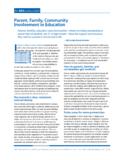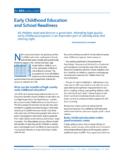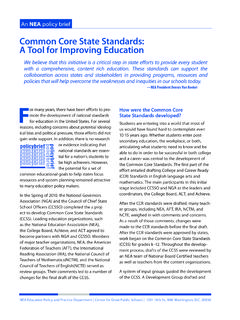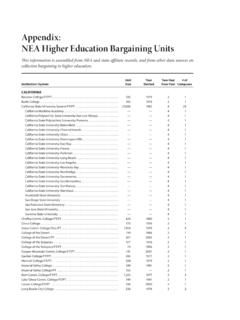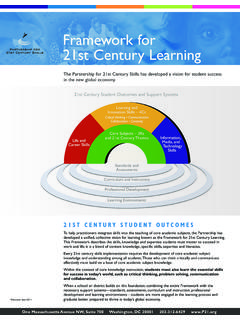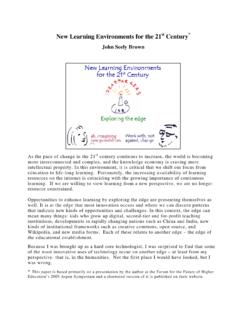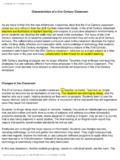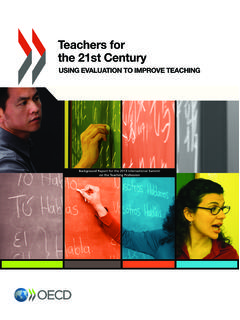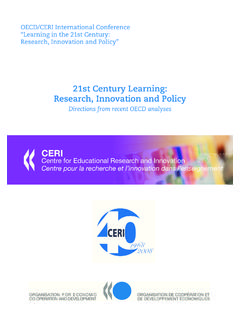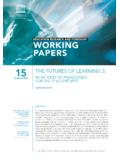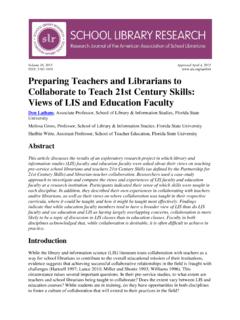Transcription of An Educator’s Guide to the “Four Cs” - nea.org
1 Preparing 21st century Students for a Global Society An Educator's Guide to the Four Cs . Great Public Schools for Every Student Table of Contents A n E d u c at o r ' s G u i d e t o T h e F o u r C s An Educator's Guide to The Four Cs Letter from Dennis Van Roekel 2. Introduction 3. The Importance of Teaching the Four Cs 5 The Four Cs 7. 1 Critical Thinking and Problem Solving 8. 2 Communication 13. 3 Collaboration 19. 4 Creativity and Innovation 24. Frequently Asked Questions 31. Next Steps and Conclusion 32. Additional Resources 34. References 36. Notes 37. P r e pa r i n g 2 1 s t C e n t u ry S t u d e n t s f o r a G l o b a l S o c i e t y 1. A n E d u c at o r ' s G u i d e t o T h e F o u r C s Dear Members and Educators, As many of you know, NEA is at the forefront of the 21st century education movement in this country. As educators, we are determined to help all students reach their full potential.
2 This is no small challenge, and it is our responsibility to prepare our young people for the unique demands of a 21st century world. As a founding member of the Partnership for 21st century Skills, NEA is extraordinarily proud of our partnerships with leaders in education, business, and policy circles to forge a common vision for education that will prepare our young people for college, work, and life. We all believe that every child should possess strong content mastery, as well as the Four Cs : critical thinking, communication, collaboration, and creativity. We designed this Guide , Preparing 21st century Students for a Global Society: An Educator's Guide to the Four Cs , to clarify this vision for classroom teachers and education support professionals. This Guide includes ideas and resources that will help advance the Four Cs in classroom practices.
3 These resources include practical techniques to integrate the Four Cs in the classroom setting;. tools for developing better proficiency in technology; and methods to ensure that students are learning in a meaningful context. It also offers suggestions for you to encourage your department, school, district, and state to embrace the Four Cs.. Though this Guide is just a step, it is designed to help you get started with ideas on how to bring the Four Cs to life in your classroom. Many of you may have started this process already, but we must all work together to improve our 21st century practices. It is clear that our school systems need to respond better to a changing world. Franklin D. Roosevelt once said, We cannot build the future for our youth but we can build our youth for the future. It is our duty to do whatever we can to help our students connect learning with real life and to provide them with the necessary skills to prepare them for success.
4 As our global economy expands, our need to prepare this next generation for new careers becomes even more imperative. If we seize this moment and work together, America's students will be our most valuable assets to compete in the 21st century . Join us in this effort. Share with us your views and best practices. Let's work together tirelessly to bring our students, our schools, our districts and our nation effectively into the 21st century . Sincerely, Dennis Van Roekel President National Education Association P r e pa r i n g 2 1 s t C e n t u ry S t u d e n t s f o r a G l o b a l S o c i e t y 2. Introduction A. ll educators want to help their students succeed in life. What was considered a good education 50 years ago, however, is no longer enough for success in college, career, and A n E d u c at o r ' s G u i d e t o T h e F o u r C s citizenship in the 21st century .
5 Using the Four Cs'. to engage students is The 21st century Skills movement is more than a decade old. Yet, educators still pose important questions about how to move imperative. As educators 21st century education forward. NEA has been an advocate of the 21st century education movement from its inception and wants to prepare students for empower educators to move it forward in their own practice. this new global society, Ten years ago, NEA helped establish the Partnership for 21st teaching the core content century Skills (P21) and in 2002 began a two-year journey to develop subjects math, social what became known as a Framework for 21st century Learning, . studies, the arts highlighting 18 different skills. In the last eight years, 16 states joined P21 and agreed to build 21st century outcomes into their standards, must be enhanced by professional development, and assessments.
6 Incorporating critical Over the years it became clear that the framework was too long and thinking, communication, complicated. To resolve this issue, we interviewed leaders of all kinds collaboration, and to determine which of the 21st century skills were the most important for K-12 education. There was near unanimity that four specific skills creativity. We need were the most important. They became known as the Four Cs . new tools to support critical thinking, communication, collaboration, and creativity. classroom teachers Now the challenge is building the Four Cs into K-12 education. and education support Discussions on this topic are pending at the federal and state levels professionals in their and in many school districts around the country. To encourage more members and leaders to incorporate this policy into their own profession, even as they instruction, NEA developed this Guide to introduce educators to the implement new strategies concept, stress the importance of the Four Cs, and put 21st century in their classrooms.
7 Education into classroom practice. Several other national organizations partnered with NEA to develop John Stocks this Guide . This group includes*: ``American Council on the Teaching of Foreign Languages (ACTFL). ``National Association for Music Education (MENC). ``National Council for Geographic Education (NCGE). ``National Council for the Social Studies (NCSS). ``National Council of Teachers of English (NCTE). P r e pa r i n g 2 1 s t C e n t u ry S t u d e n t s f o r a G l o b a l S o c i e t y 3. Introduction ``Mathematical Association of America (MAA) ``Anita Maxwell, communication and An Educator's Guide to The Four Cs instructional issues specialist, West Virginia ``National Council of Teachers of Mathematics Education Association (NCTM). ``Larry Wicks, executive director, Ohio ``National Science Teachers Association Education Association (NSTA).
8 ``Jessica Brinkley, policy analyst, Education In addition to the contributions of these Support Professionals Quality, NEA. groups, portions of the Guide were derived from materials developed by P21. We want ``Mike Kaspar, policy analyst, Education Policy to thank the P21 Board members and staff for and Practice, NEA. their dedication to the cause of 21st century ``Andrea Prejean, associate director, Education education and to developing this rich set of Policy and Practice, NEA. materials. We sincerely hope this Guide will benefit you and We would also like to thank the following your colleagues as you advance the work of the members of the NEA leaders, members, and Four Cs and the preparation of your students staff who were responsible for reviewing multiple for the challenges of 21st century lives. drafts of this document. They include: *The full list of partners is listed in the ``Daryl Gates, NEA IDEA Resource Cadre, Additional Resources section of this Guide .
9 Louisiana Education Association ``Bobbi Ciriza Houtchens, NEA ELL Culture & Equity Committee, teaching ambassador fellow, Department of Education, California Teachers Association ``Jeri Stodola, ESP network engineer and ESPRT member, Illinois Education Association ``Blake West, president, Kansas National Education Association ``Peg Dunlap, director, Instructional Advocacy, Kansas National Education Association ``Roxanne Fonoimoana, Uniserv, Oregon Education Association P r e pa r i n g 2 1 s t C e n t u ry S t u d e n t s f o r a G l o b a l S o c i e t y 4. The Importance of Teaching the Four Cs . A. merica's system of education was built for an economy and a society that no longer exists. In the manufacturing and agrarian economies that existed 50 years ago, it A n E d u c at o r ' s G u i d e t o T h e F o u r C s was enough to master the Three Rs (reading, writing, and I'm calling on our nation's governors and arithmetic).
10 In the modern flat world, the Three Rs simply aren't enough. If today's students want to compete in this global society, however, they must also be proficient communicators, state education chiefs creators, critical thinkers, and collaborators (the Four Cs ). to develop standards Students need to master additional subject areas, including and assessments that foreign languages, the arts, geography, science, and social studies. don't simply measure Educators must complement all of those subjects with the Four Cs . to prepare young people for citizenship and the global workforce. whether students can fill in a bubble on a test, but Arne Duncan, secretary of the Department of Education, has been a proponent of integrating new skills into classrooms, proclaiming, whether they possess I want to develop a system of evaluation that draws on 21st century skills like meaningful observations and input from [teachers'] peers, as well problem-solving and as a sophisticated assessment that measures individual student growth, creativity, and critical thinking.



